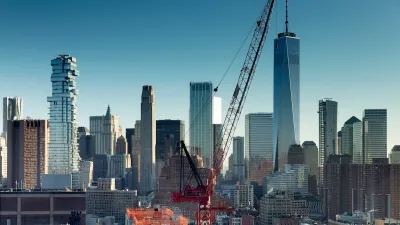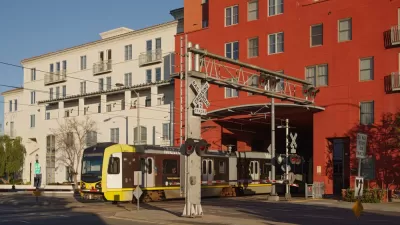Research supports the argument that increased densities reduce vehicle miles traveled, even in areas with minimal transit service.
A few weeks ago, I read a startling claim in an email discussion group. Someone wrote that at densities above 20 households per acre (roughly that of a streetcar suburb),* increased density had little effect on driving. If this was the case, the environmental argument for allowing higher densities would obviously be weaker.
After searching for data relevant to this claim, I found a 1994 study by John Holtzclaw (available here). Based on data from numerous California cities, Holtzclaw created a model designed to quantify the relationship between density and automobile vehicle miles traveled (VMT).**
Holtzclaw concluded that even in areas with minimal transit service, density affected VMT. For example, in an area with only two buses per hour, a census tract with 20 households per acre drove about 40 percent less per household than one with two units per acre (15,374 per year as opposed to 27,339). But VMT did not stop dropping at the 20 households per acre level. An area with 100 households per acre drove 1/3 fewer miles than the 20-per-acre neighborhood (10,028 VMT per household) and one with 500 households per acre drove 40 percent less than the area witih 100 households per acre (5781).
A similar density/VMT relationship existed in areas with generous public transit. Holtzclaw calculated that in a place with 100 buses/trains per hour within a quarter mile, a census tract with 2 units per acre produced 20,308 VMT per household per year, and a tract with 20 households per acre produced about 45 percent fewer miles (11,420). Under these circumstances, an area with 100 households per acre drove about 1/3 fewer miles than the 20-units-per-acre census tract (7637), and an area with 500 households per acre drove about 40 percent less than the area with 100 per acre (4295).
VMT statistics in actual neighborhoods supported Holtzclaw's model. For example, in the city of San Francisco, VMT per household averaged 11,256 miles. By contrast, in the Nob Hill/North Beach area (which had 100 households per acre, as opposed to 48 for the city as a whole) VMT per household was less than half that (5519). In sum, it appears (at least based on Holtzclaw's model) that even at densities of 100 households per acre or more, higher density means less driving.
Moreover, Holtzclaw's model may slightly understate the influence of density on driving. Why? Because higher density, by allowing more people to live near bus or train stops, makes improved transit service possible- which itself seems to reduce driving.***
Why does any of this matter? Because if the most compact neighborhoods drive less than 20 household-per-acre streetcar suburbs, it follows that additional infill in already-compact neighborhoods, by increasing density, will reduce VMT. If this is the case, then additional infill is justified on environmental grounds, even in neighborhoods that are already far more compact than the average American suburb.
*Because there are 640 acres in a square mile, this corresponds to 12,800 households per square mile in a heavily residential area. San Francisco's Sunset District has roughly this density, as do the more compact parts of Upper Northwest Washington, DC.
**The numbers produced by Holtzclaw's model are at Table 7 of the paper.
***Though perhaps not as much as higher density. For example, in the super-dense neighborhood with 500 units per acre, the difference between 2 buses per hour and 100 per hour produced a change from 5781 VMT/household/year to 4295- a change much smaller than the difference between either neighborhood and the lower-density areas.

Manufactured Crisis: Losing the Nation’s Largest Source of Unsubsidized Affordable Housing
Manufactured housing communities have long been an affordable housing option for millions of people living in the U.S., but that affordability is disappearing rapidly. How did we get here?

Americans May Be Stuck — But Why?
Americans are moving a lot less than they once did, and that is a problem. While Yoni Applebaum, in his highly-publicized article Stuck, gets the reasons badly wrong, it's still important to ask: why are we moving so much less than before?

Research Shows More Roads = More Driving
A national study shows, once again, that increasing road supply induces additional vehicle travel, particularly over the long run.

Judge Halts Enforcement of Anti-Homeless Laws in Grants Pass
The Oregon city will be barred from enforcing two ordinances that prosecute unhoused residents until it increases capacity and accessibility at designated camping sites.

Advancing Sustainability in Los Angeles County Schools
The Los Angeles County Office of Education’s Green Schools Symposium brings together educators, students, and experts to advance sustainability in schools through innovative design, climate resilience strategies, and collaborative learning.

Using Old Oil and Gas Wells for Green Energy Storage
Penn State researchers have found that repurposing abandoned oil and gas wells for geothermal-assisted compressed-air energy storage can boost efficiency, reduce environmental risks, and support clean energy and job transitions.
Urban Design for Planners 1: Software Tools
This six-course series explores essential urban design concepts using open source software and equips planners with the tools they need to participate fully in the urban design process.
Planning for Universal Design
Learn the tools for implementing Universal Design in planning regulations.
City of Moreno Valley
Institute for Housing and Urban Development Studies (IHS)
City of Grandview
Harvard GSD Executive Education
NYU Wagner Graduate School of Public Service
City of Cambridge, Maryland
Newport County Development Council: Connect Greater Newport






























